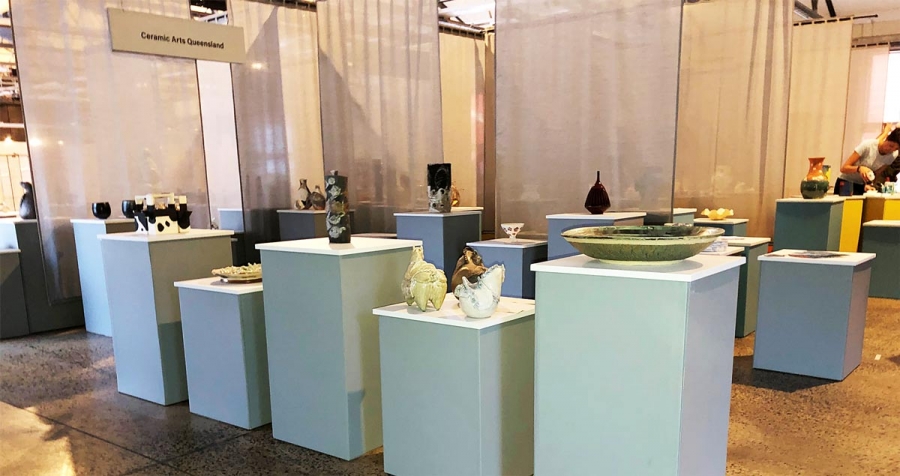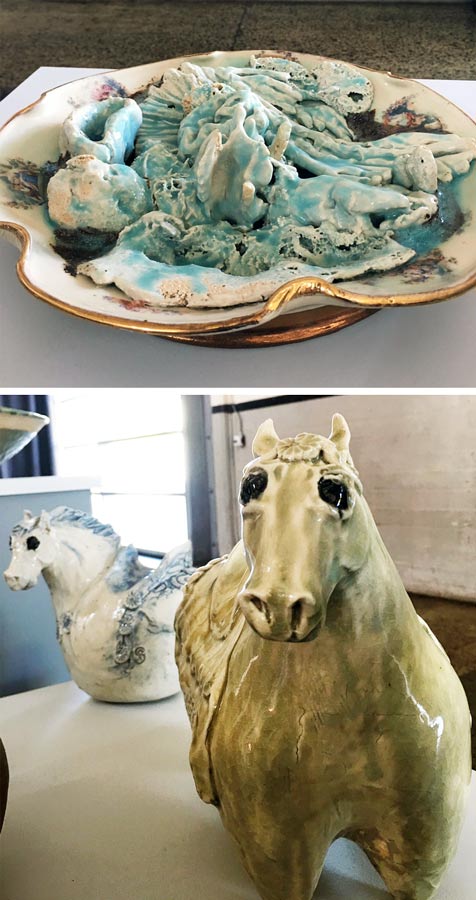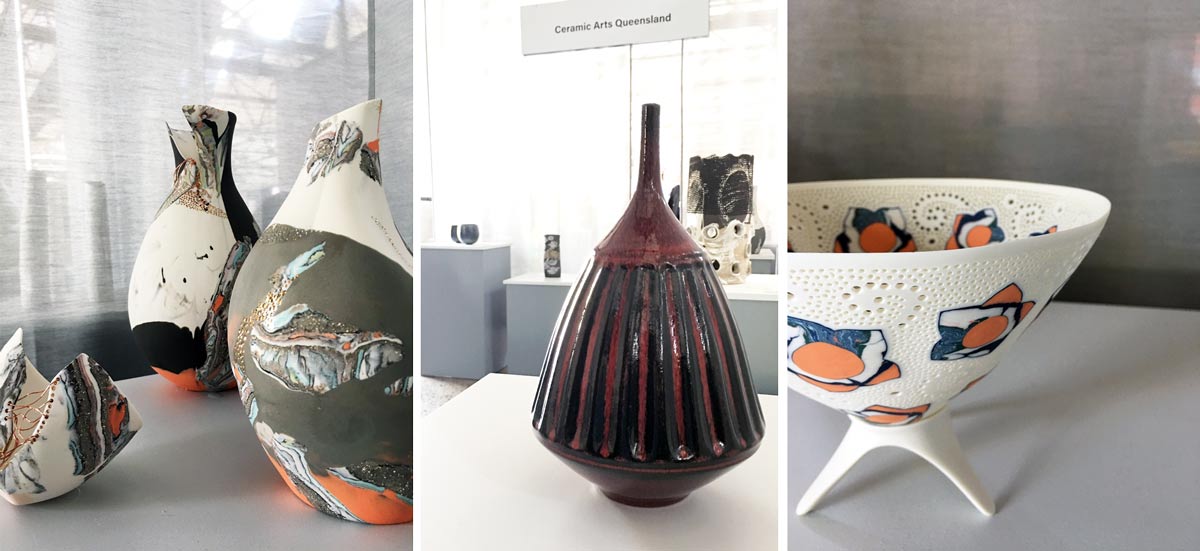At the closing session of the recent Australian Ceramics Triennale in Hobart, 1-4 May 2019, the 700 strong audience was invited to assemble again in Central Australia. The re-birth of interest in ceramics will undoubtedly see this as a hugely popular destination, favoured as it is with many environmental aspects so compatible with living with, working with and firing clay.
The experience in Hobart confirmed just how wondrous is the level of involvement, creativity, and camaraderie within the growing ceramic community.
Young and old, new-comers and frequent attendees immersed themselves in 4 days of talks, demonstrations and exhibitions. Multiple choices had many moving quickly from place to place, while others settled comfortably to absorb the generous sharing of knowledge and experiences.
Held in the vast Princes Wharf 1 building it was so convenient to have all the conference events under one roof, or almost. Last-minute registrations had the organisers (an amazing team of 4), expanding seating and spaces to absolute capacity, adding two marquees to the perimeter courtyards for demonstrations.
CAQ had a presence, along with other Australian ceramic-interest groups, in the exhibition section of the venue. Representation was limited to those who could deliver their work on set-up day and 14 artists took part: Julie Shephard, Liz Izquierdo, Michaela Kloeckner, Dianne Peach, Sandra Robertson, Megan Puls, Anne Mossman, Larissa Warren, Bill Powell, Sue Fraser, Johanna DeMaine, Evelyne Upton, Molly Bosworth, and the collaborative work of Johanna DeMaine and Tatsuya Tsutsui under the brand name Kayabuki Kobo.
The organisers kept secret the colour of the plinths, except that all the tops were greyish white. The grey/black background of PW1 was illuminated by oranges and yellows, blues and greys of the cleverly designed painted cardboard box plinths. Ours were mid-grey and very complimentary to the work. What we lacked in lighting was compensated for by the corner position, which gave excellent exposure to all. Five pieces were sold along with many appreciative comments.
Other exhibitions in the space included TACA’s “Manifest – the art and design of contemporary Australian ceramics”, curated by Damon Moon, showing selected artist’s works with diverse approaches to the medium, and the “Presenters Exhibition”, showing the work of the national and international speakers and demonstrators.
“Holding Space” displayed works by both current and past Tasmanian ceramic artists/potters, all influential in the development of ceramic knowledge in this state and exposing the exceptional strength of the craft in this comparatively small geographical area.
A cameo collection of pieces by Prue Venables celebrated her award bestowed in 2018 as the 9th ‘Living Treasure – Master of Australian Craft’ by the Australian Design Centre.
The Pot Shop inside the venue and the Saturday Market in the forecourt was where opportunities for delegates to sell, and buy, from an amazing array of wares rarely seen ‘under one roof’.
Eight exhibitions in nearby Salamanca drew delegates to the buzz of this popular recreational precinct, and almost as many galleries were a short walk away in the CBD. The Tasmanian Museum & Art Gallery showed five separate groupings of ceramics from their collection spanning decades.
The ‘serious’ business of the conference was presented under daily themes, the first being “Contemporary Meets History”. The custom of Triennale’s is to examine all aspects of ceramic practice; the practical, theoretical, philosophical, experimental, conceptual, ephemeral, ethical, and even more mind-bending angles.
There was a lot of valuable talking, mostly in the mornings when our heads were somewhat clearer, with afternoons broken up by moving from Derwent Stage to Kunanyi (Mt Wellington) Stage, demo to demo, browsing exhibitions and trade displays, and of course, meeting old friends and making new ones. It was impossible to do/see it all!
But one session I’m so glad I didn’t miss was the “Glaze Chemistry Workshop” by Curt McDonald from WA. Expecting 20 booked delegates the overflow (double the number including me) were standing, leaning, for hours to hear the presentation. It went all afternoon, and I was lucky to get a chair mid-way through, but honestly, I was prepared to stand for the duration. This old potter, me, doesn’t know it all, and it was so enlightening to hear this complicated topic dealt with in such a rudimentary and methodical manner. Supported by generous handouts and references (mostly from Hamer & Hamer – essential reference book – Curt held our attention to the last second. Not to say we have it all clear in our heads, yet, but we all have a new appreciation of and awe for the depths to which we can go in understanding this fascinating subject.
Another highlight of the event took place on the second last evening in the entry courtyard – the opening of the “petal kiln” designed and fired by Andres Allik. Three days of wood stoking by the dedicated team concluded at 1300˚ and the fibre-lined petals were opened like a flower, sparks rising into the clear, cold night, to reveal the 3m high sculpture made by Nanna Bayer and Selena De Carvalho – as if they didn’t have enough to do getting the whole show on the road!
Skipping to the last day, and getting a wee bit overloaded, the theme was “Onwards and Upwards”. The morning was free for The Makers’ Fair and the adjacent famous Salamanca Market. After lunch, one of the many speakers, Amy Kennedy, talked about her experiences as an Artist in Residence, as she has been engaging in these for many years in many localities around the world.
Tips on how to apply, both for positions and funding, were invaluable. I came away with the feeling though that more preparation was needed in sourcing and applying than in doing the actual residency.
I was surprised by a brief encounter regarding ceramic durability when Ian Clare, demonstrating his making of functional ware, dropped, purposely, a thrown lemon-shaped hand squeezer he’d brought with him. It bounced on the concrete floor! Impressed! The story goes that Ian leaves a small hole in the hollow form until it is almost dry (and shrunk) and then fills it in. “No, it won’t explode in the gloss firing”, Ian says.
The internal air/gas is compressed by the shrinkage in the final firing but not sufficiently to split the form. And when you drop it, the internal pressure seems to counteract the external shock of the drop. Can’t wait to try it with my eggs!
And this brings me to the final Closing Address by Glen Barkley, the Closing Ceremony, and the revelation of where the next gathering will be in 3 years’ time. Glenn’s closing Keynote Address touched on his experiences with clay as a practitioner, lecturer, judge, and curator, amongst other activities he enjoys, all of which influence his various artistic pursuits. Glenn became prominent in recent years for his outspoken appreciation of expressive rather than tidy craftsmanship, and fuelled debate amongst practitioners about the superiority/inferiority of such works, and whether these are ‘cutting edge’ or remnants of similar movements in the 70s: or just playful doodles or “kindergarten” art.
The questions from the audience indicated that this debate is not over yet, and I was tempted to think it a good launching pad for discussion when next, we all meet in Alice Springs. Hope to see you there!
The impressive exhibition works of the CAQ members at the 2019 Hobart Triennale
CAQ at the Triennale: Michaela Kloeckner and below Susanne Fraser
Ceramic Arts Qld members work: From left to right: Larissa Warren, Bill Powell and Julie Shepherd
CAQ at the Triennale: The work of Anne Mossman (top) and Dianne Peach (bottom)




